
These evaluation reports cover a wide variety of construction products. They provide information about what code requirements or acceptance criteria were used to evaluate the product, how the product should be installed to meet the requirements, how to identify the product, and much more. ES Reports are divided into eleven major areas.
For example, If you're inspecting a commercial building, and you know what kind of roof system is installed, you can look up the installation requirements using these reports. Also siding and many other types of products.
REPORT EVALUATION DIRECTORY (Choose "Reports arranged by CSI")
Check out:
- Thermal and Moisture Protection
- Wood, Plastics, and Composites
How to Read an Evaluation Report
1. CSI Division Number—ICC-ES Evaluation Reports, and the building products represented in them, are organized according to the Construction Specifications Institute’s (CSI) Masterformat system.
2. Report Holder—The name and address of the company or organization that has applied for the Evaluation Report.
3. Evaluation Subject—The specific product(s) covered by the report.
4. Evaluation Scope—The code(s) that were used to evaluate the product.
5. Properties Evaluated—A brief description of the properties the product was evaluated against such as fire resistance and wind resistance. This section also shows if the product can be used for structural purposes.
6. Uses—Identifies the scope of the Evaluation Report and relates the product evaluated to code provisions.
7. Description—Provides a general description of the product and its features, such as length, thickness, etc.
8. Installation—Identifies general and often specific requirements to help the inspector ensure the product is installed properly according to the code requirements or acceptance criteria.
9. Conditions of Use—Statement that the product, as described in the Evaluation Report, complies with or is a suitable alternative to the requirements of the applicable code and a list of conditions under which the report is issued.
10. Evidence Submitted—Data (i.e. test reports, calculations, installation instructions) that was used in evaluating the product.
11. Identification—Information that can be used to identify the product, including the manufacturer’s name, product code, Evaluation Report number, etc.
These reports cover most materials and products an inspector is likely to encounter and have questions about, and unlike online searches or asking on online forums, this information is accurate and detailed!
